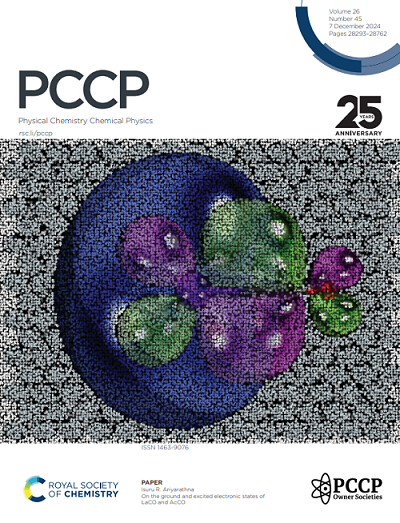Steric effects in the adsorption of O2 on a Cu(111) surface
IF 2.9
3区 化学
Q3 CHEMISTRY, PHYSICAL
引用次数: 0
Abstract
Probing the stereodynamics of a gas-surface interaction is a useful tool to investigate the mechanisms responsible for adsorption. Experimental results are provided on the adsorption of alignment-controlled O2 interacting with a Cu(111) surface for the first time, across a range of incident energies (65–550 meV) and angles of incidence (0–60°). Molecules of O2 in a supersonic beam are prepared in a single spin-rotational state, and aligned with a Cu(111) surface so that the rotational angular momentum of O2 is either parallel or perpendicular to the surface. A strong steric effect is observed, where the initial sticking probability is higher in case of a "side-on" (or "broadside") collision, with measurable adsorption appearing at normal incident energies of 100 meV. The onset of sticking occurs at incident energies of approximately 200 meV in case of an "end-on" collision. The results also indicate that the adsorption of O2 on Cu(111) is predominantly due to an activated process in the energy range probed, corroborating previous experimental and theoretical results求助全文
约1分钟内获得全文
求助全文
来源期刊

Physical Chemistry Chemical Physics
化学-物理:原子、分子和化学物理
CiteScore
5.50
自引率
9.10%
发文量
2675
审稿时长
2.0 months
期刊介绍:
Physical Chemistry Chemical Physics (PCCP) is an international journal co-owned by 19 physical chemistry and physics societies from around the world. This journal publishes original, cutting-edge research in physical chemistry, chemical physics and biophysical chemistry. To be suitable for publication in PCCP, articles must include significant innovation and/or insight into physical chemistry; this is the most important criterion that reviewers and Editors will judge against when evaluating submissions.
The journal has a broad scope and welcomes contributions spanning experiment, theory, computation and data science. Topical coverage includes spectroscopy, dynamics, kinetics, statistical mechanics, thermodynamics, electrochemistry, catalysis, surface science, quantum mechanics, quantum computing and machine learning. Interdisciplinary research areas such as polymers and soft matter, materials, nanoscience, energy, surfaces/interfaces, and biophysical chemistry are welcomed if they demonstrate significant innovation and/or insight into physical chemistry. Joined experimental/theoretical studies are particularly appreciated when complementary and based on up-to-date approaches.
 求助内容:
求助内容: 应助结果提醒方式:
应助结果提醒方式:


